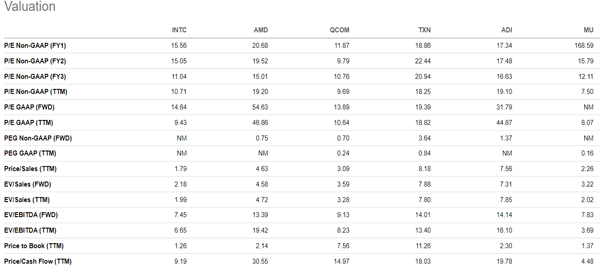We all want to buy cheap items and sell them at a higher price. This happens in all industries, including real estate, commodity trading, and stocks.
Of course, even in trading, unless you focus only on short selling, the same principle applies: we want to buy at a cheap price and make profits by selling at a higher price.
So let’s get to the point–how can we find stocks that will guarantee us this profit? In this article, we will look at the concept of undervalued stocks, how to find them, and some strategies to use.
Table of Contents
What are undervalued stocks?
An undervalued stock is defined as one that is being valued at a lower price than its intrinsic value. For example, assume that a company generates $1 billion in free cash flow per year. If the company has a market cap of $1.5 billion, it can be said to be undervalued.
The opposite of an undervalued company is one that is overvalued. Assume that the company mentioned above has a market cap of $50 billion. In this case, assuming no growth, the company will take over 50 years for its free cash flow to cover its market cap.
In most cases, long-term investors prefer buying undervalued companies and hope that the market will value them well over time. This investing strategy is known as value investing.
Related » Value Investor VS Trader: Why Prefer Trading!
Undervalued stocks are only suited for investors and not day traders. Investors are people who buy stocks and hold them for a long time.
Traders, on the other hand, are people who are only interested in short-term moves in the market. As such, they are not interested in the core fundamental value of stocks.
Related » You should consider a SWOT analysis!
Why stocks get undervalued
A key theory in the financial market is known as the efficient market theory. It states that a company’s stock price reflects all available information on the company.
Therefore, if a company’s market cap is $10 billion, the efficient market hypothesis is that this valuation reflects all information that investors know.
Industries
There are several reasons why stocks get undervalued. First, they get undervalued because of their industries. In some periods, investors focus on certain sectors and ignore others.
For example, in the past decade, they were focusing on growth stocks and ignored those in the oil and gas sector. As a result, energy stocks were significantly undervalued.
Performance
Second, stocks get undervalued because of their underperformance. In most cases, investors sell shares of companies that have a long track record of delivering weak quarterly and annual results.
At times, as they sell these shares, their prices tend to decline as well.
Macro
Third, stocks get undervalued because of macro factors. At times, shares can become extremely cheap when the Federal Reserve decides to hike interest rates or when there are geopolitical concerns globally.
Further, some sectors are usually not so attractive to investors, which tends to cause shares to be a bit undervalued. Other reasons why companies get undervalued are bad news in a company or industry, cyclical events, and bad management.
How to tell that a stock is undervalued
There are two main strategies to tell whether a stock is undervalued or not.
Multiple analysis
The easiest way to tell whether a stock is undervalued is to conduct a multiples analysis. This is a strategy that looks at several multiples and then compare them with those of other companies in the industry. There are several multiples that you can consider in this analysis:
- Price-to-earnings (PE) – This multiple compares a stock’s price and its past or future earnings. A lower PE ratio is a sign that a company is undervalued.
- Price-to-sales (PS) – This multiple compares a stock’s price with its overall sales. In most cases, this is usually not the best measure of valuation since investors are interested in what a company generates in earnings.
- EV to EBITDA – This measure compares a company’s enterprise value with its EBITDA. In most cases, many investors believe that it is a better measure of a company’s valuation.
- Price to free cash flow – This multiple measures a company’s stock price with its free cash flow.
The chart below shows a multiple comparison of Intel. In it, we see that the stock is undervalued compared to AMD, its biggest rival in most metrics.

Discounted Cash Flow (DCF)
Another strategy to determine whether a stock is undervalued is known as the Discounted Free Cashflow (DCF).
DCF is a long and complicated strategy that determines a company’s valuation based on its future cash flow. The idea is that a company’s valuation is based on how well it can generate future free cash flows.
A common mistake that people make is to assume that the stock’s nominal price makes it undervalued. It is possible for a stock that is trading at $100 to be undervalued than one that is trading at $5.
How to find undervalued stocks
These days, it is relatively easy to find stocks that are undervalued. This process has been made easier by the fact that many companies like Yahoo Finance and Investing provide free screeners.
A screener is a tool that makes it possible for you to rank companies based on several metrics such as those mentioned above. Look for companies that:
- Shares have lagged the market and peers – Identify good quality companies whose stock prices has fallen sharply in the past few months or years.
- Low multiples – Look at companies that have relatively lower earnings and sales multiple, as mentioned above.
- Look for a catalyst – Look at companies that are undervalued and have a catalyst that could push their share prices higher.
- Dividend yield – Companies with a high dividend yield tends to be relatively undervalued.
Investing strategies for undervalued stocks
As mentioned above, traders don’t put a lot of emphasis on undervalued stocks. Instead, these stocks are usually focused by long-term value investors. Here are some of the top tips for investing in undervalued stocks:
- Be diversified – Incorporate growth stocks into your value investing strategy.
- Do more research – Always do intensive research before you invest in an undervalued company. Understand why it is undervalued in the first place.
- Have a catalyst in mind – Always ensure that you have a catalyst that will push the stock significantly higher.
- Dividends – Invest in value stocks that have dividends to offset a deterioration in stock prices.
Summary
Well, you should now have assessed what undervalue stocks are and how to find them. And we should have understood one very important thing: this strategy is not very effective for day traders, but should be used for medium or long time horizons.
We have also assessed some of the top strategies to use when investing in them.
External useful resources
- Find undervalued stocks with these indicators – DBS.com





